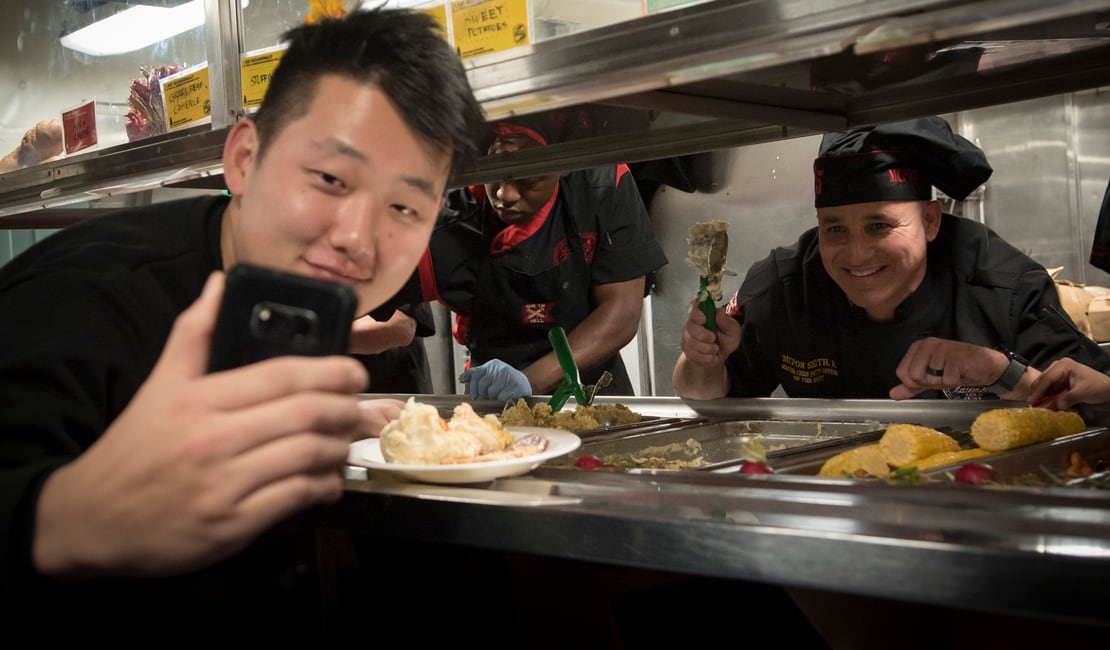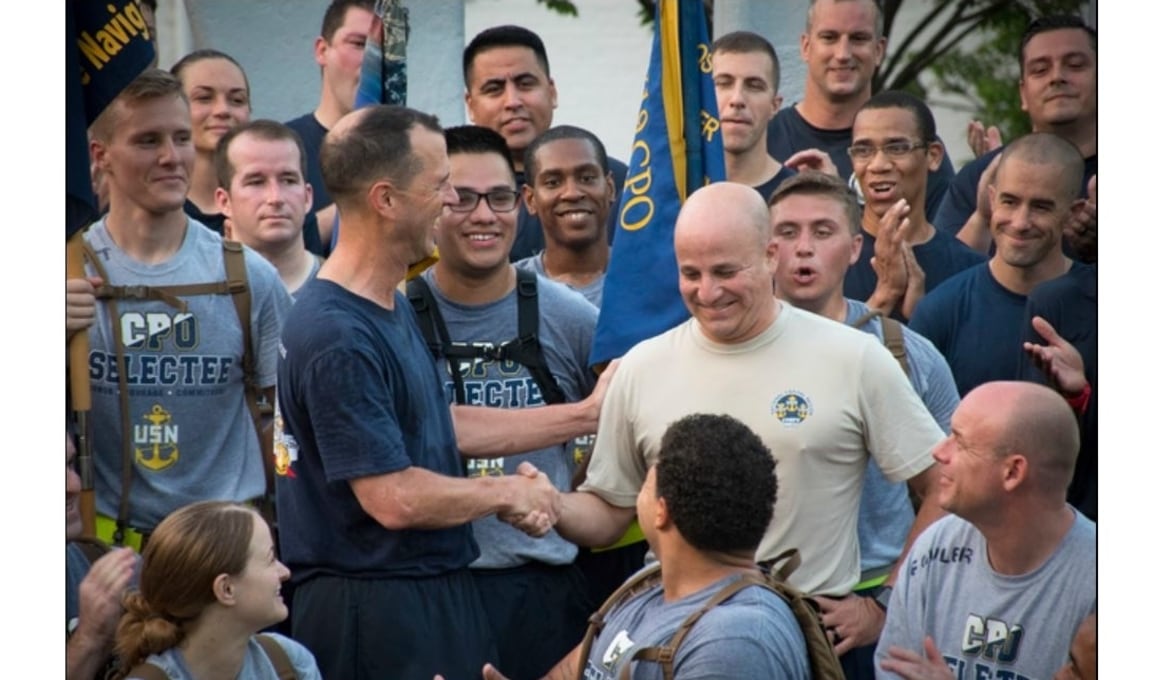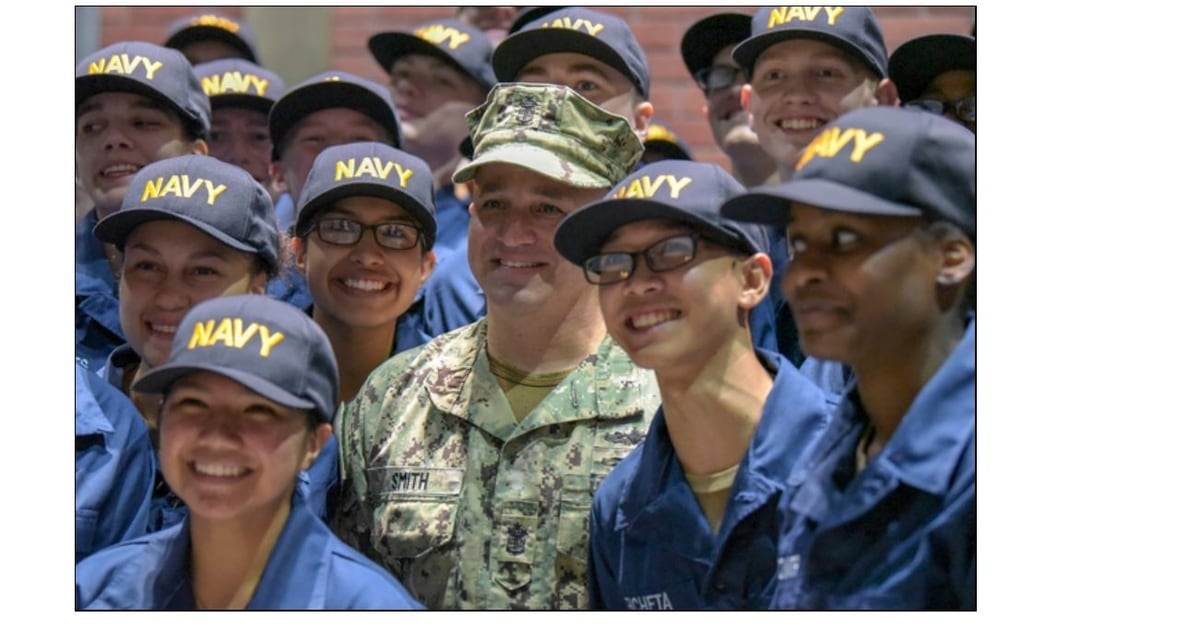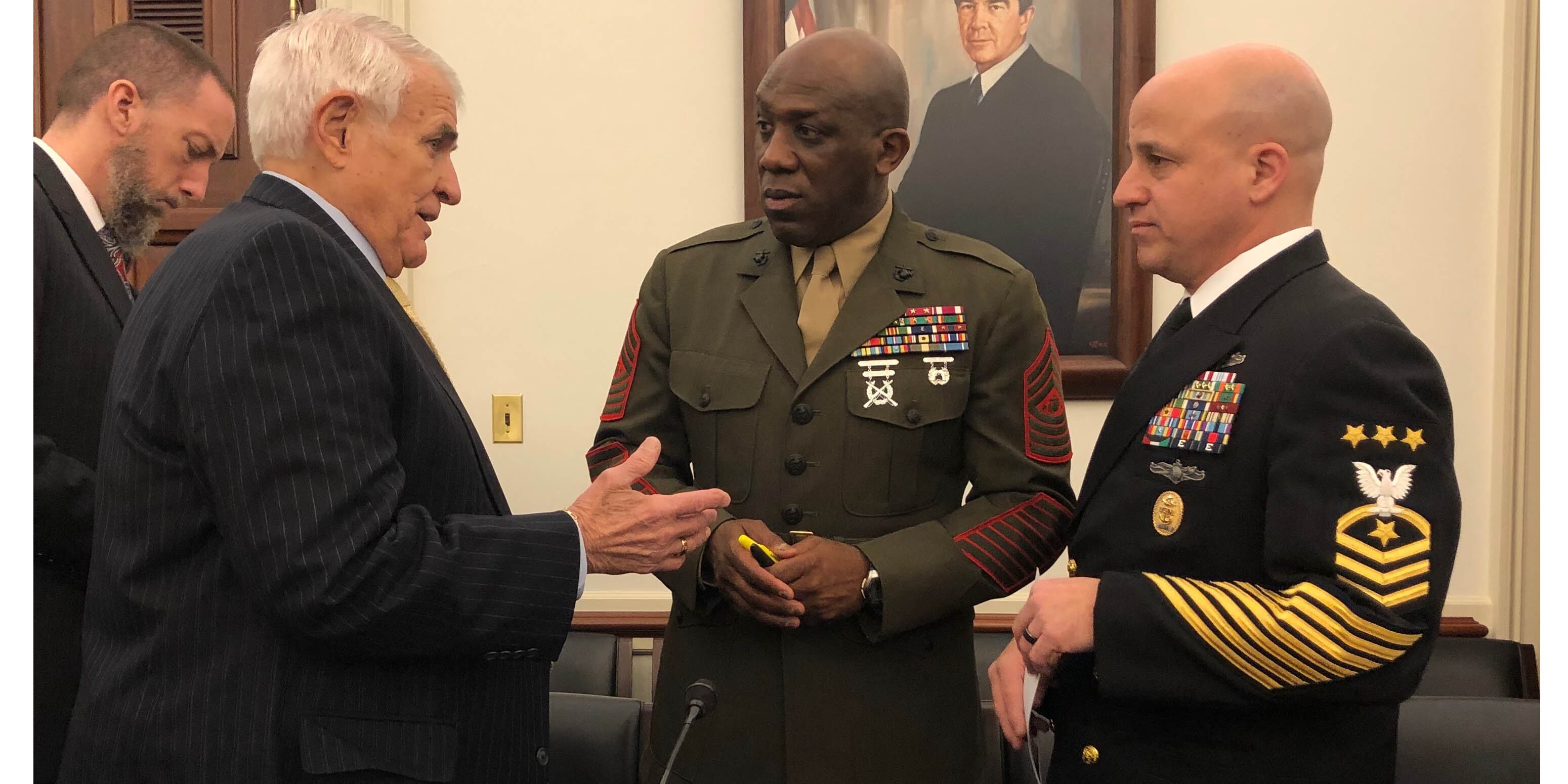It was six days before Christmas and the 15th Master Chief Petty Officer of the Navy glanced around an office nestled into the outermost E-Ring of the Pentagon.
There were a few photos taped to the wall. Several boxes of memorabilia collected over his three decades in the Navy were neatly stacked but mostly unopened.
“It’s a work in progress,” exhaled Smith, shortly before one of the pictures broke loose from the frame and hit the deck.
But you can’t blame him for not settling in after four months as the MCPON.
He never expected to take the post. He was dragooned to serve as the interim MCPON on June 22, a day after Steven Giordano suddenly resigned following allegations that he fostered a hostile work environment there.
It wasn’t until Aug. 29 that Chief of Naval Operations Adm. John Richardson named Smith as the Navy’s top enlisted sailor. Instead of setting up a bureaucratic beachhead inside the Pentagon, Smith immediately launched into a flurry of flights across the globe on behalf of his boss, their service and our nation.
South Korea. Italy. Boston and Philadelphia. A tour with CNO of hurricane-ravaged Panama City, Florida, a powwow with recruits and top training officials at Great Lakes, a visit to the 7th Fleet’s flagship Blue Ridge in Japan.
He served Thanksgiving mashed potatoes to the crew of the aircraft carrier Harry S. Truman as it sailed the Mediterranean Sea. He jetted to the other side of the planet to convene a Naval Station North Island meeting to find more ways to support sailors and their families.
“Travel is going to be something we do because you don’t get a second chance to make a first impression,” Smith said, before adding that he might “need to slow that a bit.”

Living out of a seabag isn’t unusual for Smith, who served on board the aircraft carriers Enterprise, Carl Vinson and Abraham Lincoln and the guided-missile destroyer Momsen, plus time inside SEAL Team 4.
As the fleet master chief to the Navy’s top personnel officer, he logged about 245 days on the road or at sea annually, he figures, but it’s all part of a process of finding out what’s happening on the piers, reporting the impressions of sailors to admirals in Washington, D.C. and then advising CNO on crafting policies that make sense.
“Getting out and hearing firsthand what they have to say and seeing firsthand what they’re going through and finding out what’s on their minds is critical,” he said.
“The other side of this job is where you need to bring those fleet comments and opinions into meetings where admirals are going to consider what enlisted people need and want, and then move the rocks that change the enlisted experience.”
And now that he’s semi-situated in the Pentagon, here’s what he wants to change: cutting red tape and pointlessly difficult procedures that keep enlisted personnel from mastering their craft, especially the art of war at sea.
He vows to end the distractions that block sailors from learning their trades and getting ahead.
He demands ethical petty officers and chiefs who are trained to be leaders.
And he’s pushing for objective ways to measure performance across the entire fleet so that commanders can advance people on merit, judging them for their brains, grit and competence and not collateral duties or meaningless qualifications that won’t help them do their jobs.
“I want to avoid this becoming a bumper sticker, because it can if we’re not careful, but it’s critical that sailors get the sense of urgency that today’s world situation brings to the table,” he said. “The idea that we can just sail anywhere in the world that we want to without concern and then execute combat operations when and where we want to isn’t going to be our future and we know that.”

Smith wants sailors to “be more practiced” in seamanship, their weapons and other skills that atrophied during two decades of ground warfare in Iraq and Afghanistan.
He’s helping to prod the Navy to “take away the things that won’t help them” survive combat at sea.
“We need to prepare more urgently than we have from a damage control, firefighting and readiness perspective,” Smith said. “That muscle memory that gets built by skill and repetition and not focusing on collateral duties and warfare pins that are not in your skill discipline — things that are superfluous to what you do in your technical specialty, that distract you from being good at your job.”
It’s a swing back from a Navy that lurched too far into expanding warfare qualification so that more sailors could pursue them.
Reforming that is just another step toward ditching training and credentialing that won’t “help them in their job directly and only distracts them,” he said.
Smith also pointed to reforms he and other senior leaders are exploring to unburden sailor taking heavy loads of college courses just to get ahead.
“Don’t get me wrong. College is incredibly important,” said Smith.
“It teaches you critical thinking and we need to emphasize taking college courses when available. But when you have sailors who are taking excessive amounts of college course while balancing sea duty at the same time they’re trying to learn a technical specialty, that’s not a good recipe for a ship … trying to get after the high-end fight.”

While sailors relearn their reemphasized ratings, Smith wants the Navy to get better at evaluating how much they know and how well they perform their jobs.
He called the old ways of grading performance “subjective” and the push for new evals “a revolutionary step.”
It calls for stack up against a Navy-wide standard, not just against shipmates at their commands.
There are some glitches in the new eval system, like figuring out how to document qualifications and milestones that are part of the current write up section. Those records help advancement boards deliberate on selections but Smith expects it to get fixed over the next few months.
“We’re still working out some bugs and are going to have to figure out some things,” Smith said.
“I think when you ask for an honest opinion from a group of people, especially a group of master chiefs, on who likes the old eval system, about half of them will raise their hands,” he added.
“That’s not because we necessarily like it. It’s because we know how to manipulate it with tribal code and through reverse engineering to get most people to where they need to be. “

To Smith, chiefs at heart are teachers, prepping young sailors for waging war at sea and then leading them through the fight. But the Navy has struggled for the past decade at developing enlisted leaders.
The sea service once boasted commands dedicated to teaching leadership techniques and the courses were required for advancement, but units groused about losing sailors to the programs.
Fleets took on the training themselves and Big Navy shuttered many of the schools. But funding never flowed fully to the fleet efforts and trained shipboard teachers also didn’t always materialize, Smith said, and the subjects and quality of the courses varied widely.
“Some were taught in three days like they were supposed to,” Smith said. “But some were perhaps taught in a little less time. But now, they’ll be taught with the same consistency all across the fleet.”
It’s a top priority for the MCPON, who urges the Navy to “do more and step on the gas with deliberately developing leaders of character and sound ethical judgement.”
He pointed to master training teams from the Naval Leadership and Ethics Center in Newport, Rhode Island, with detachments in Norfolk and San Diego, that will target junior petty officers and chiefs.
“Their job is to travel and get out and train the messes around the world and ensure those foundational courses we teach are top notch, consistently delivered,” Smith said.
And he wants to make sure the Goat Locker isn’t left out.
“We realized and recognized that if you become a master chief in 15 or 16 years and you don’t become a CMC, you have no further professional touch points of education in your career,” he said “That’s not helpful or useful to you, so we’re developing that course.”
RELATED

Throughout his talks with Navy Times, Smith was always quick to say that he’s just a member of a staff and his goals really are the goals of his boss, the CNO. But Adm. Richardson was more direct about why he chose Smith as his MCPON.
The four-star sees him as both a great example of servant leadership for other chiefs — a sailor who always puts the team before himself, striving to improve so that he can better serve his Navy — and a bulldog with a “laser focus on warfighting.”
“He’s building a fighting Navy — fighting chiefs and fighting Navy sailors,” Richardson told Navy Times.
“He connects instantly, and I think that’s because he has a deep and abiding respect for each and every sailor. It’s fun to watch him interact. He quickly gains their trust. He’s a straight shooter with them. He tells it like it is. But he also always has a recommendation for how a sailor can better their situation. He’s authentic. Genuine.”
Mark D. Faram is a former reporter for Navy Times. He was a senior writer covering personnel, cultural and historical issues. A nine-year active duty Navy veteran, Faram served from 1978 to 1987 as a Navy Diver and photographer.








